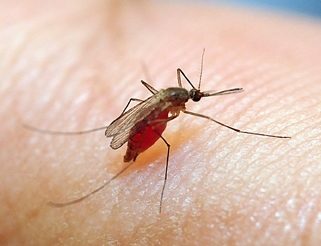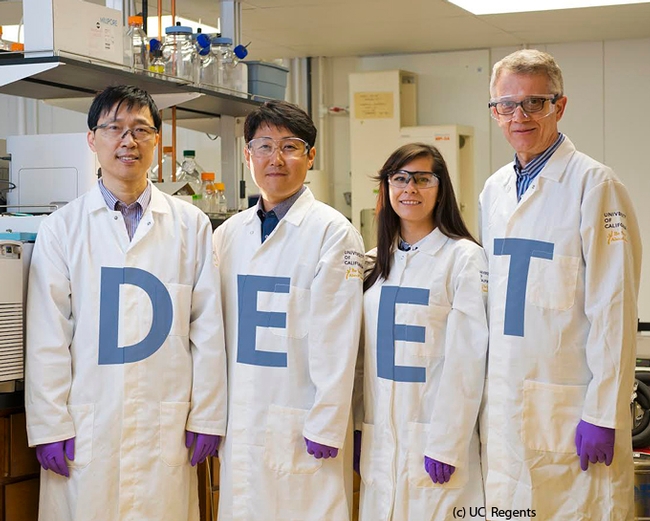
It works.
However, not everyone wants to use DEET, a synthetic insect repellent. There's that smell, for one thing. "Properties that people do not like in addition to the smell is that DEET is a solvent for plastic," says chemical ecoloigst Walter Leal of the University of California, Davis. "So, one gets eyeglass frames and watchbands dissolved by DEET."
There's also "the misconception that everything synthetic is bad."
So what is it with DEET that repels mosquitoes? What odorant receptor is involved? Mosquitoes, as we know, detect smells with their antennae.
The Leal lab today (Oct. 27) published research in the Proceedings of the National Academy of Sciences (PNAS) that pinpoints the exact odorant receptor that repels them. They also identified a plant defensive compound that might mimic DEET, a discovery that could pave the way for better and more affordable insect repellents.

For more than six decades, DEET has been known as the gold standard of insect repellents. More than 200 million people worldwide use the chemical insect repellent, developed by scientists at the U.S. Department of Agriculture and patented by the U.S. Army in 1946.
So when Leal and his team--project scientist Pingxi Xu, postdoctoral scholar Young-Moo Choo, and agricultural and environmental chemistry graduate student Alyssa De La Rosa-- published their groundbreaking research, “Mosquito Odorant Receptor for DEET and Methyl Jasmonate,” they drew global attention.
In their research, they examined the receptors of the southern house mosquito, Culex quinquefasciatus, which transmits such diseases as West Nile virus.
The researchers set out to investigate two hypotheses regarding DEET's mode of action: activation of ionotropic receptor IR40a vs. odorant receptor(s). “Ionotropic receptor is another family of olfactory receptors, which seem to be the ancestral version when insects were aquatic,” Leal said. “So, the ionotropic receptors normally detect acid, bases, and other water soluble compounds.”

“Vector-borne diseases are major health problems for travelers and populations living in endemic regions,” said Leal. “Among the most notorious vectors are mosquitoes that unwittingly transmit the protozoan parasites causing malaria and viruses that cause infections, such as dengue, yellow fever, chikungunya, and encephalitis.”
Leal said that diseases transmitted by mosquitoes destroy more lives annually “than war, terrorism, gun violence, and other human maladies combined. Every year, malaria decimates countless lives – imagine a city of San Francisco perishing to malaria year after year. The suffering and economic consequences in endemic areas are beyond imagination for those living in malaria-free countries. Both natives and visitors to endemic areas want to keep these ‘infected needles' at bay. In the absence of vaccines for malaria, dengue, and encephalitis, one of the most ancient and effective prophylactic measures against mosquito-borne diseases is the use of DEET.”
Dan Strickman of the Bill and Melinda Gates Foundation, not involved in the study, praised the work. “We are at a very exciting time for research on insect repellents,” said Strickman, senior program officer of the Global Health Program's Vector Control. “ For decades, the field concentrated on screening compounds for activity, with little or no understanding of how chemicals interacted with mosquitoes to discourage biting. Use of modern techniques that combine molecular biology, biochemistry, and physiology has generated evidence on how mosquitoes perceive odors.”
Said zoologist Paul Weldon of the Smithsonian's Conservation Biologist Institute, also not involved in the study: “Since DEET is strictly synthetic and not a natural product, it has been challenging to understand the adaptive nature of the response it elicits. It is not as if the compound emanates from, say, spider webs or fishy water, where avoidance by mosquitoes would make sense. Xu et al. have solved the mystery of where the DEET response comes from: it is in response to plant chemical defenses.”
“This, by the way, also explains why the DEET response is widespread, occurring in many arthropods, including those that are not ectoparasitic -- like cockroaches,” Weldon said. The repellence of other arthropods by DEET may have tipped off some of those investigating the DEET response, but I'm not sure that it did. The focus of research on DEET seems to have been with the organisms in which it just so happened to be discovered -- mosquitoes. The Xu et al. study suggests that there is a much broader array of DEET-sensitive organisms than previously suspected. No doubt, this finding will assist further investigations of it.”
Professor John Pickett, Rothamsted Research, UK, also not involved in the study, called the link between the plant compound and synthetic insect repellent, DEET as a “surprising evolutionary link.”
Pickett, the Michael Elliott Distinguished Research Fellow and Scientific Leader of Chemical Ecology at Rothamsted Research and a foreign associate of the National Academy of Sciences, said: “Not only does this work demonstrate that a mosquito response to the gold standard repellent DEET, as well as the more recently developed repellents, is mediated by a specific odorant receptor (OR136 for the southern house mosquito Culex quinquefasciatus) but that the receptor responds specifically also to methyl jasmonate, involved in plant hormone-based defense against insects, which suggests a surprising evolutionary link between these types of insect interactions.”
The UC Davis researchers pointed out that “insect repellents have been used since ancient times as prophylactic agents against diseases transmitted by mosquitoes and other arthropods, including malaria, dengue fever, and encephalitis. They were developed from plant-based smoke or extracts (essential oils) into formulations with a single active ingredient.”
Progress toward development of better and more affordable repellents has been slow, they said, because scientists weren't sure which odorant receptor was involved. Now they are.
Mosquito researcher Anthony "Anton" Cornel, associate professor with the UC Davis Department of Entomology and Nematology, and based at the UC Kearney Agricultural Research and Extension Center, Parlier, provided the mosquitoes that allowed the Leal lab to duplicate his mosquito colony at UC Davis.
Look for more exciting research to come!
Attached Images:
